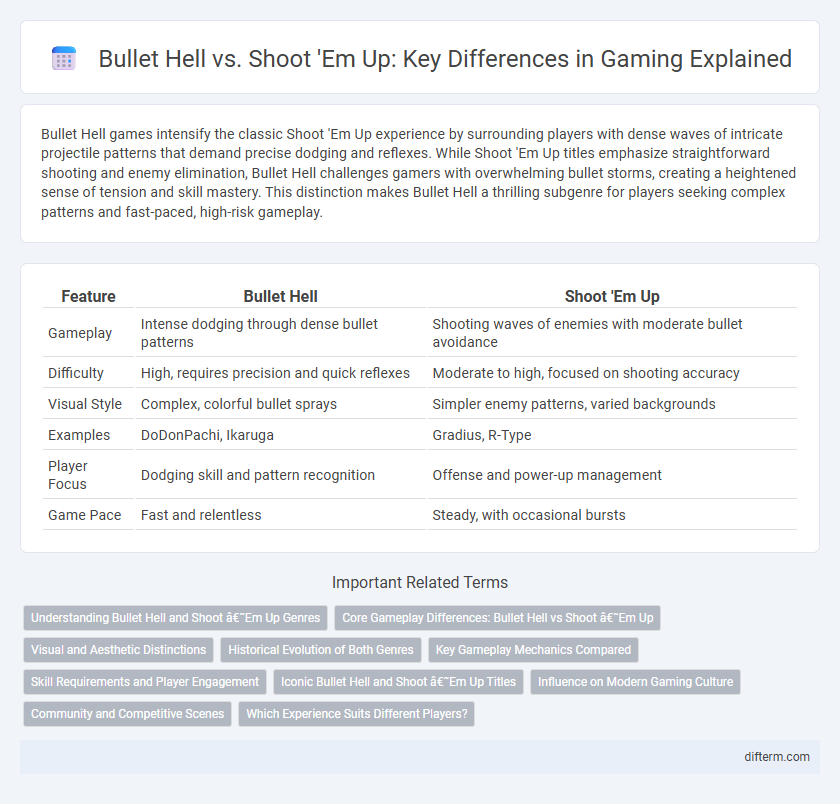Bullet Hell games intensify the classic Shoot 'Em Up experience by surrounding players with dense waves of intricate projectile patterns that demand precise dodging and reflexes. While Shoot 'Em Up titles emphasize straightforward shooting and enemy elimination, Bullet Hell challenges gamers with overwhelming bullet storms, creating a heightened sense of tension and skill mastery. This distinction makes Bullet Hell a thrilling subgenre for players seeking complex patterns and fast-paced, high-risk gameplay.
Table of Comparison
| Feature | Bullet Hell | Shoot 'Em Up |
|---|---|---|
| Gameplay | Intense dodging through dense bullet patterns | Shooting waves of enemies with moderate bullet avoidance |
| Difficulty | High, requires precision and quick reflexes | Moderate to high, focused on shooting accuracy |
| Visual Style | Complex, colorful bullet sprays | Simpler enemy patterns, varied backgrounds |
| Examples | DoDonPachi, Ikaruga | Gradius, R-Type |
| Player Focus | Dodging skill and pattern recognition | Offense and power-up management |
| Game Pace | Fast and relentless | Steady, with occasional bursts |
Understanding Bullet Hell and Shoot ‘Em Up Genres
Bullet Hell games, a subgenre of Shoot 'Em Up, feature intense, screen-filling bullet patterns requiring precision dodging and reflexes, emphasizing survival amid overwhelming projectile density. Shoot 'Em Up games generally focus on shooting enemies from a variety of angles with simpler patterns, prioritizing fast-paced action and strategic positioning. Understanding these core mechanics highlights the Bullet Hell's demand for skillful navigation compared to the broader, action-driven gameplay of Shoot 'Em Up titles.
Core Gameplay Differences: Bullet Hell vs Shoot ‘Em Up
Bullet Hell games feature dense, intricate bullet patterns requiring precise navigation and constant movement, emphasizing dodging skills and reflexes. Shoot 'Em Up titles focus on shooting waves of enemies with simpler projectile patterns, prioritizing offensive strategy and power-ups. The core gameplay difference lies in Bullet Hell's intense dodging mechanics versus Shoot 'Em Up's balanced attack and defense dynamic.
Visual and Aesthetic Distinctions
Bullet Hell games feature dense patterns of intricate, colorful projectile streams that create a visually overwhelming experience, emphasizing precision and evasion. Shoot 'Em Up titles tend to showcase more straightforward enemy designs with fewer, larger bullets and a clearer, more spacious screen layout, emphasizing fast-paced shooting and movement. The aesthetic in Bullet Hell often incorporates neon-lit, futuristic themes, while Shoot 'Em Up games vary widely, ranging from classic pixel art to modern 3D environments.
Historical Evolution of Both Genres
Bullet Hell and Shoot 'Em Up genres evolved from the arcade scene of the 1980s, with Shoot 'Em Up games like Space Invaders and Galaga laying the groundwork through relatively simple enemy attack patterns. Bullet Hell, also known as danmaku, emerged in the 1990s as a subgenre characterized by intricate, dense projectile patterns that demanded precise player navigation and reflexes, prominently showcased by series like Touhou Project and Ikaruga. This evolution reflects a shift from straightforward shooting mechanics to complex, pattern-based gameplay, highlighting advancements in game design and player skill expectations.
Key Gameplay Mechanics Compared
Bullet Hell games feature intense screen-filling projectiles requiring precise dodging and pattern memorization, emphasizing agility and reflexes. Shoot 'Em Up games prioritize straightforward enemy waves and power-ups, focusing on shooting accuracy and strategic positioning. Both genres challenge player skill but differ mainly in the density of bullets and the complexity of attack patterns.
Skill Requirements and Player Engagement
Bullet Hell games demand exceptional hand-eye coordination and rapid reflexes due to dense, intricate projectile patterns, pushing player skill to the limit. Shoot 'Em Up titles offer a broader range of difficulty levels, balancing accessibility with moments requiring strategic movement and precision shooting. Player engagement in Bullet Hell is driven by mastering complex patterns, while Shoot 'Em Up retains interest through varied enemy designs and power-up mechanics.
Iconic Bullet Hell and Shoot ‘Em Up Titles
Games like "Touhou Project" and "Ikaruga" stand out as iconic bullet hell titles, renowned for their intense, intricate bullet patterns and high difficulty levels. Classic shoot 'em ups such as "Gradius" and "R-Type" emphasize strategic weapon upgrades and enemy wave management, shaping the genre's legacy. Both subgenres continue to influence modern game design, showcasing their distinct gameplay mechanics and enduring player appeal.
Influence on Modern Gaming Culture
Bullet Hell games, characterized by their intense patterns of projectiles and precise dodging mechanics, have significantly influenced modern gaming culture by pushing the limits of player skill and concentration. Shoot 'Em Up titles laid the foundation for this genre with their fast-paced action and enemy wave patterns, inspiring innovations in game difficulty scaling and visual design. Both genres contributed to the popularity of challenging gameplay loops and cultivate a dedicated community focused on mastery and high-score competition.
Community and Competitive Scenes
Bullet Hell games foster tight-knit communities driven by shared mastery of complex patterns and high-score achievements, while Shoot 'Em Up titles attract broader audiences with accessible gameplay and varied competitive formats. Community forums and leaderboards in Bullet Hell emphasize precision and endurance, creating intense rivalries among elite players. In contrast, Shoot 'Em Up competitions often integrate team-based and casual tournaments, enhancing inclusivity and expanding their competitive scene.
Which Experience Suits Different Players?
Bullet Hell games, characterized by intense screen-filling projectile patterns, are ideal for players who enjoy high-difficulty challenges requiring precise reflexes and strategic dodging skills. Shoot 'Em Up games offer a more accessible pace with straightforward enemy waves, appealing to players seeking fast action and classic arcade-style gameplay. Casual gamers often prefer Shoot 'Em Up's simpler mechanics, while hardcore players gravitate towards Bullet Hell's demanding complexity and adrenaline-pumping intensity.
Bullet Hell vs Shoot ‘Em Up Infographic

 difterm.com
difterm.com